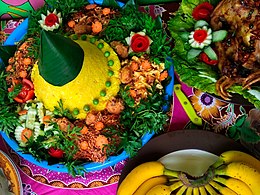

This article needs additional citations for verification. Please help improve this articlebyadding citations to reliable sources. Unsourced material may be challenged and removed.
Find sources: "Peranakan cuisine" – news · newspapers · books · scholar · JSTOR (June 2019) (Learn how and when to remove this message) |

 |
| This article is part of the series on |
| Indonesian cuisine Masakan Indonesia |
|---|
|
National dishes |
|
Regional and cultural cuisines |
|
Ingredients |
|
Types of food
|
|
Preparation and cooking
|
|
Styles |
|
Holidays and festivals |
|
Related cuisines |
|
See also |
|
|
|
|
 |
| This article is part of the series on |
| Malaysian cuisine Masakan Malaysia |
|---|
|
Regional and cultural cuisines |
|
Ingredients |
|
Types of food
|
|
Holidays and festivals |
|
Related cuisines |
|
See also |
|
|
|
|
Peranakan cuisineorNyonya cuisine comes from the Peranakans, descendants of early Chinese migrants who settled in Penang, Malacca, Singapore and Indonesia, inter-marrying with local Malays. In Baba Malay, a female Peranakan is known as a nonya (also spelled nyonya), and a male Peranakan is known as a baba. The cuisine combines Chinese, Malay, Javanese, South Indian, and other influences.
Nyonya cooking is the result of blending Chinese ingredients with various distinct spices and cooking techniques used by the Malay/Indonesian community. This gives rise to Peranakan interpretations of Malay/Indonesian food that is similarly tangy, aromatic, spicy and herbal. In other instances, the Peranakans have adopted Malay cuisine as part of their taste palate,[1] such as assam fish and beef rendang. Key ingredients include coconut milk, galangal (a subtle, mustard-scented rhizome similar to ginger), candlenuts as both a flavoring and thickening agent, laksa leaf, pandan leaves (Pandanus amaryllifolius), belachan, tamarind juice, lemongrass, torch ginger bud, jicama, fragrant kaffir lime leaf, and cincalok – a powerfully flavored, sour and salty shrimp-based condiment that is typically mixed with lime juice, chillies and shallots and eaten with rice and other side dishes.
There are regional variations in Nyonya cooking. Dishes from the island of Penang in the northern part of Peninsular Malaysia possess Thai influences, such as more liberal use of tamarind and other sour ingredients. Dishes from Singapore and Malacca show a greater Indonesian influence, such as the use of coconut milk. A classic example is laksa (a spicy noodle soup), which comes in two variants: the sour asam laksa from Penang and the coconut milk-based laksa lemak from Singapore and the southern regions of Peninsular Malaysia.
The flavor of laksa and other Nonya recipes is determined by the rempah, which in Malay means spices. The various combinations are pounded into a paste with a mortar and pestle, with a very specific texture and density. It is said that a Nyonya can determine the culinary skill of a new daughter-in-law simply by listening to her preparing rempah with a mortar.[2] Nonya recipes are handed down from one generation to the next, and because of the time-consuming preparation of these dishes, it is a cuisine that is often at its best when served at home. Laksa is a notable exception to this rule.
Examples of Nonya specialities include otak-otak, a popular blend of fish, coconut milk, chilli paste, galangal, and herbs wrapped in a banana leaf;[3] ayam buah keluak, a distinctive dish combining chicken pieces with nuts from the Pangium edule or kepayang tree to produce a rich sauce; and itek tim, a classic soup containing duck, tomatoes, green peppers, salted vegetables, and preserved sour plums simmered gently together.
Nonya desserts include colourful cakes (kue) and sweet, sticky delicacies.
|
| |||||||||||||
|---|---|---|---|---|---|---|---|---|---|---|---|---|---|
| Common dishes |
| ||||||||||||
| Snacks |
| ||||||||||||
| Desserts |
| ||||||||||||
| Drinks |
| ||||||||||||
| Condiments |
| ||||||||||||
| |||||||||||||
|
| |||||||
|---|---|---|---|---|---|---|---|
| Articles |
| ||||||
| Dishes |
| ||||||
| Snacks and desserts |
| ||||||
| Drinks |
| ||||||
|
| |
|---|---|
| Continental |
|
| National and regional |
|
| Ethnic |
|
| Religious |
|
| Historical |
|
| Styles |
|
| Lists |
|
| Related |
|
| |
|
| |||||||||||||||||||||
|---|---|---|---|---|---|---|---|---|---|---|---|---|---|---|---|---|---|---|---|---|---|
| Dishes by origin |
| ||||||||||||||||||||
| By type and origin |
| ||||||||||||||||||||
| By type |
| ||||||||||||||||||||
| |||||||||||||||||||||